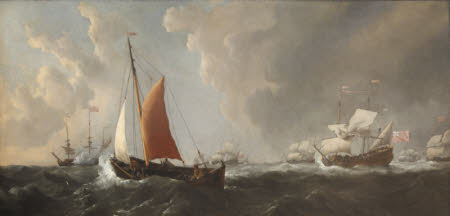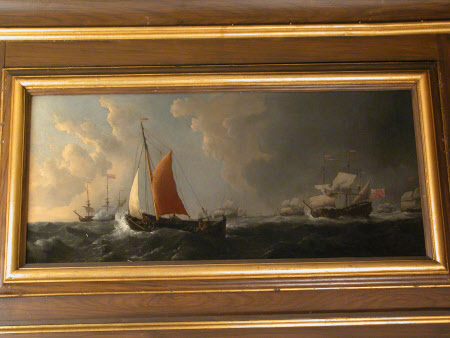Storm: An English Galliot Beating to Windward in a Gale
Willem van der Velde the younger (Leyden 1633 – London 1707)
Category
Art / Oil paintings
Date
1673 (signed and dated)
Materials
Oil on canvas
Measurements
622 x 1448 mm (24 1/2 x 57 in)
Order this imageCollection
Ham House, Surrey
NT 1139762
Summary
Oil painting on canvas, Storm: An English Galliot beating to Windward in a Gale by Willem van der Velde the younger (Leyden 1633 – London 1707), signed and dated: van de velde Londe 1673. An English galliot beating to windward in a strong breeze. A rough day in the open sea with the wind from the left of the picture. Strong light from the left with storm clouds on the right. To the left, viewed from abaft the port beam, a galliot without her mizzen or a similar vessel close-hauled on the starboard tack under a brown gaff mainsail reefed and a white foresail also reefed. She is lifting to sea. Across the background is a squadron of English ships, two-deckers or smaller, close-hauled on the starboard tack, sailing towards the admiral at anchor in the left background, who is firing a gun to port as a signal. This flagship has a red ensign at the main. On the right in the middle-distance is a ship under fore course and mizzen, the main topsail shaking and being lowered and the fore topsail lowered on the cap; she has a pendant at the fore below a vane. On the extreme right is a ship with flag at the fore and in the distance beyond is a ship with flag at the mizzen as rear-admiral. The vessel in the foreground is like a Dutch kaarg, but she is too long and too fine aft; a kaarg was mainly an inland waterways vessel and did not normally have a gaff rig; a striped van at the masthead may be Dutch. The flagships all have red ensigns as flags, as in another Ham House picture of 1673, a small English ship becalmed (no.348). The vanes also have the St George in the upper corner. In this case the ships can in no way be connected with the Board of Ordnance and the vanes and flags must be the mistake of the artist. The pendant under a vane on the ship on the right was a Dutch custom and is probably also a mistake. A ship of the Royal Navy in the 17th century would not have flown even a plain red flag at the main, as that would have signified an admiral of the red squadron, who in that position would have flown a Union Jack.
Provenance
Set of four overdoor seapieces by Willem van der Velde the Younger commissioned in 1673; in 1677 inventory and thence by descent until acquired in 1948 by HM Government when Sir Lyonel, 4th Bt (1854 – 1952) and Sir Cecil Tollemache, 5th Bt (1886 – 1969) presented Ham House to the National Trust, and entrusted to the care of the Victoria & Albert Museum, until 1990, when returned to the care of the National Trust, and to which ownership was transferred in 2002
Credit line
Ham House, The Dysart Collection (purchased by HM Government in 1948 and transferred to the National Trust in 2002)
Makers and roles
Willem van der Velde the younger (Leyden 1633 – London 1707), artist

